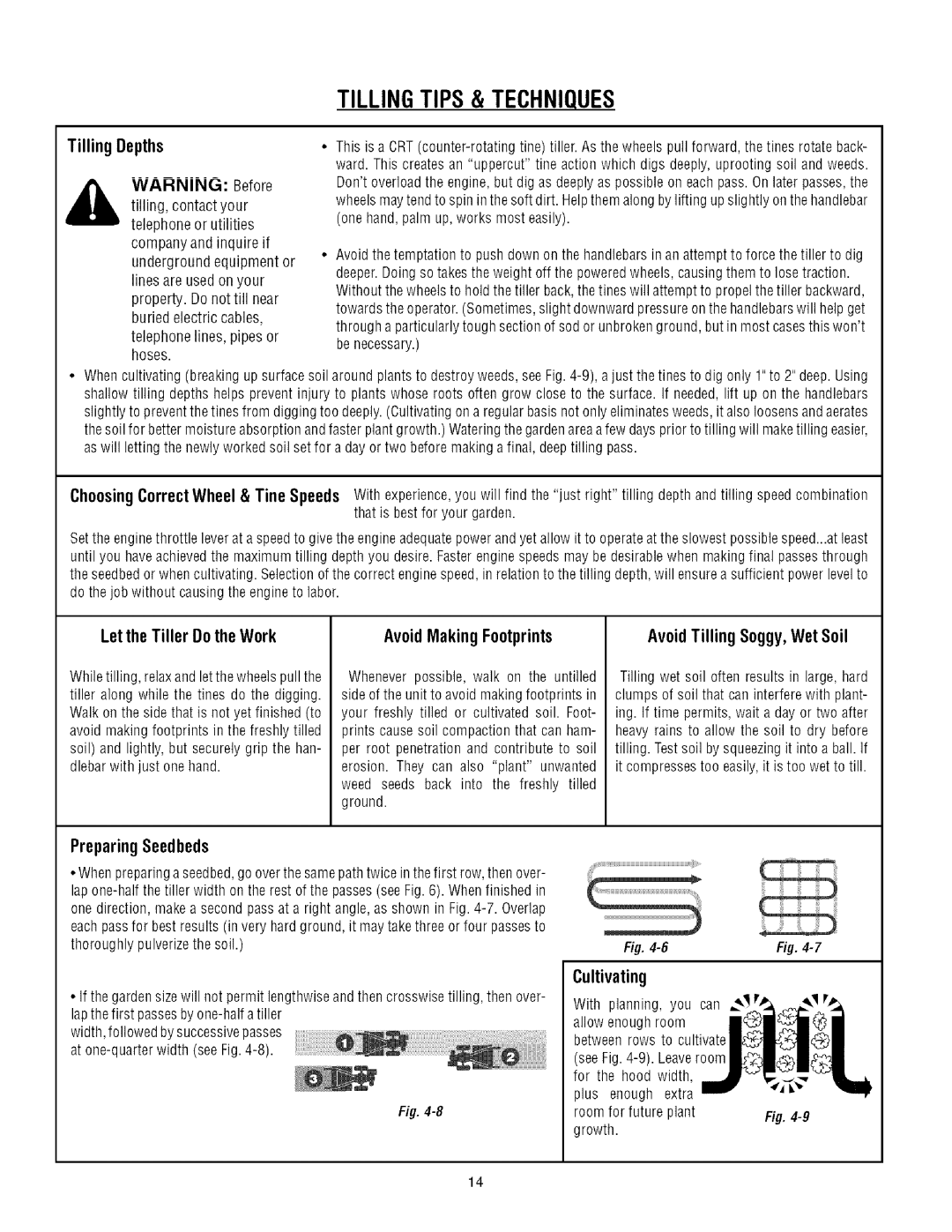
TILLINGTIPS& TECHNIQUES
Tilling Depths
WAHNING: Before
tilling, contact your telephone or utilities company and inquire if undergroundequipment or lines are usedon your property. Do not till near buriedelectric cables,
telephone lines, pipes or hoses.
This is a
Avoidthe temptationto pushdown on the handlebarsinan attemptto force thetiller to dig deeper.Doingso takesthe weightoff the poweredwheels,causingthemto lose traction. Withoutthe wheelsto holdthe tiller back,the tineswill attemptto propelthe tiller backward, towardsthe operator.(Sometimes,slightdownwardpressureonthe handlebarswill helpget througha particularlytough sectionof sod or unbrokenground, but in most casesthiswon't benecessary.)
•Whencultivating(breakingup surfacesoil aroundplantsto
ChoosingCorrectWheel & Tine Speeds With experience,you will find the "just right" tilling depth andtilling speedcombination that is bestfor your garden.
Setthe enginethrottle leverat a speedto givethe engineadequatepowerandyetallow it to operateat the slowestpossiblespeed...atleast until you haveachievedthe maximumtilling depth you desire. Fasterenginespeedsmaybe desirablewhen makingfinal passesthrough the seedbedor whencultivating. Selectionof the correct enginespeed,in relationto the tilling depth,will ensurea sufficientpower levelto do the jobwithout causingthe engineto labor.
Let the Tiller Dothe Work | AvoidMaking Footprints | AvoidTilling Soggy,Wet Soil |
Whiletilling, relaxandletthe wheelspullthe tiller along while the tines do the digging. Walkon the side that is not yet finished(to avoid makingfootprints in the freshly tilled soil) and lightly, but securelygrip the han- dlebarwith just onehand.
Wheneverpossible, walk on the untilled sideof the unit to avoid makingfootprints in your freshly tilled or cultivated soil. Foot- prints causesoil compactionthat can ham- per root penetrationand contribute to soil erosion. They can also "plant" unwanted weed seeds back into the freshly tilled ground.
Tilling wet soil often results in large,hard clumps of soil that can interferewith plant- ing. If time permits,wait a day or two after heavyrains to allow the soil to dry before tilling. Testsoil by squeezingit into a ball. If it compressestoo easily,it is too wet to till.
Preparing Seedbeds
•Whenpreparingaseedbed,go overthe samepathtwice inthefirst row,then over-
thoroughlypulverizethe soil.) | Fig. |
•If the gardensizewill not permitlengthwiseandthencrosswisetilling, then over- lapthefirst passesby
width,followedby successivepasses | ....................v |
at | _ _ |
| Fig. |
Cultivating
With planning, you can ==.._vp. | ==_.v__ | ||
allow enoughroom | _" | _ | (_ |
betweenrows to cultivate | _ | _ |
|
_ |
| ||
for the hood width, |
|
|
|
plus enough extra _ |
| _' |
|
room for future plant |
| Fig. | |
growth. |
|
|
|
14
